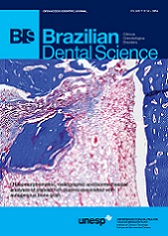Bonding to bleached enamel treated with 10% sodium bicarbonate: a one-year follow-up
DOI:
https://doi.org/10.14295/bds.2014.v17i4.1046Abstract
Objective. This article is a brief review about in vitro proposals to overcome the low bond strength values to bleached dental surfaces through a one-year follow-up case report of the immediate replacement of composite resin restorations after enamel bleaching. Clinical considerations. The presence of residual oxygen after bleaching may be responsible for inhibiting the polymerization of the monomers present in the adhesive systems, leading to the failure of the restorative procedure. The use of antioxidants, especially the 10% sodium bicarbonate solution (SB), could be a fast and practical alternative to improve the bond strength of these restorations. In office bleaching with hydrogen peroxide 35% (Lase Peroxide Sense, DMC, Ribeirão Preto, SP, BRA) was performed followed by the removal of the unsatisfactory restorations. Then, the BS was applied and the new adhesive restorations were placed. After one year, the clinical performance of the restorations were successful, showing no signs of failure nor infiltration. Conclusions. The use of the 10% sodium bicarbonate in bleached enamel seems to be a viable alternative for clinical practice.
Downloads
Downloads
Additional Files
Published
How to Cite
Issue
Section
License
Brazilian Dental Science uses the Creative Commons (CC-BY 4.0) license, thus preserving the integrity of articles in an open access environment. The journal allows the author to retain publishing rights without restrictions.
=================




























